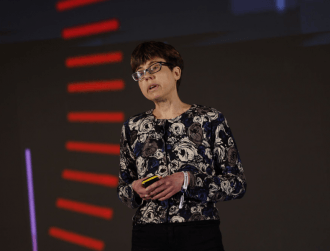In Chip War: The Fight for The World’s Most Critical Technology, Prof Chris Miller explains how the fragile semiconductor supply chain and the geopolitical system are inextricably linked.
There’s an extreme shortage of the chips that are used to train artificial intelligence systems today, with almost 90pc of AI systems being trained on chips produced by just one company. That’s the stark reality laid out by author and economic historian Prof Chris Miller in his book, Chip War: The Fight for The World’s Most Critical Technology, a Financial Times Business Book of the Year.
“In many ways, the world as we know it today relies on a very fragile foundation of thousands and thousands of silicon chips, and the semiconductor industry is becoming increasingly politicised as competition between countries impacts the entire electronics industry,” he said, addressing a rapt audience at the IFA Leadership Summit in Berlin earlier this month.
That growing politicisation is unsurprising when we remember that the origin of semiconductors is not in making chips for smartphones or for home devices, but in missile systems.
“The first semiconductors that were invented in the 1950s and 1960s were precisely for use in missile guidance systems. The entire chip industry, the chips that power all consumer electronics today have their origins in defence systems like these,” Miller says.
“It’s still the case that militaries see semiconductors as absolutely central to their role.”
One need only look at current geopolitical conflicts to see this in action, says Miller.
“Chips are playing a central role in all of that, whether it’s missiles like the Javelin anti-tank missiles that Ukraine has used to great effect in fighting against Russia. Even simple missiles like these – they were designed first in the 1980s – have hundreds of semiconductors inside of them. Or, if you look at more advanced communication systems, like the Starlink Low Earth Orbit satellite network that has helped Ukraine keep its communications online over the course of the war, they’re even more reliant on even more sophisticated semiconductors.”
East Asia arms race
And it’s not only in the Russia-Ukraine War where semiconductors will be absolutely central because today in east Asia there is what Miller describes as “an extraordinarily dangerous and destabilising arms race underway”.
“Every military in east Asia is preparing for a new era of conflict. And as militaries today think about the future of warfare, they’re envisioning military systems that are defined more than ever before by semiconductors,” says Miller.
In the same way consumer companies are thinking about ways to apply AI and autonomy to new devices, militaries are thinking about applying AI and autonomy to new military systems, he says.
It all means that militaries will require far more semiconductors in the coming years than they do now, and just like the civilian economy, they will face a fundamental challenge, which is that the application of AI requires enormous amounts of computing power.
AI and Moore’s Law
Miller stresses the point that it’s computing power that has made possible the proliferation of artificial intelligence in all sorts of different use cases.
“Indeed, the demand for computing power today is so severe that there’s a desperate shortage of the very chips that are used to train artificial intelligence systems. Today, it’s estimated that 90pc of AI systems like OpenAI systems are training their artificial intelligence systems on chips produced by one company, Nvidia, now worth a trillion dollars because it’s chips are absolutely central to the future of AI.”
According to Miller, Nvidia’s chips are in such high demand in Silicon Valley, there are venture capital firms that will invest in start-ups not by giving them dollars, but rather by giving them GPU chips.
“In other words, access to compute has fundamentally been a limiting factor in the training of AI systems,” says Miller. “Which is why today it’s not just companies that are interested in controlling access to compute, but governments as well. The result is more and more governments intervening in ways that are unprecedented, as they try to control who can access these chips and who cannot.”
Five key countries
Miller says there are just five countries that matter when it comes to producing the chips that make AI possible – the US, Japan, Korea, Taiwan and the Netherlands, and indeed one need only look at revenue share in the chip industry to find that almost all the revenue accrues to these five countries.
“No one else is remotely significant,” he says. “No one else has any advanced technology that matters. It’s just these five countries that produce the technology necessary to produce AI chips, and all of these five countries are tightening their rules over talent flows, over intellectual property, over the transfer of machine tools and the transfer of chips themselves, because they want their technology and the AI it enables to be controlled by companies they trust, not countries they don’t.”
The proverbial elephant in the room is of course China, one of the world’s major players in the electronics ecosystem, yet it plays a tiny role when it comes to manufacturing chips and an almost non-existent role when it comes to manufacturing cutting-edge chips, according to Miller.
“China is so reliant on imported semiconductors that it spends as much money each year importing chips as it spends importing oil. And it has to import almost all of its chips from countries that aren’t just commercial competitors, but are also geopolitical adversaries.”
You might wonder why China hasn’t developed the tools to make their own advanced chips. Miller stresses that “advanced chips are the most complex machines humans have ever made.”
Miller points to the EUV (extreme ultraviolet) Lithography Machine produced by just one company in the world, ASML in the Netherlands. “These machines cost roughly $150m to buy and they have hundreds of thousands of components inside of them. There’s nothing more complex than these machines in all of human history. So replicating something this sophisticated is extraordinarily hard.”
Playing catch up
Not only this, but the tools are improving on a regular basis. “Already ASML is planning its next generation EUV Lithography machines that will be arriving in a year or two. So, catching up to the chip industry isn’t about catching up to a stable status quo. It’s catching up in the most rapid race humans have ever run,” says Miller.
“The trend in the chip industry has not been of people catching up to the cutting edge, but of falling behind. Over the last decade, everyone has fallen behind the market leader. And that trend holds in every single segment of the semiconductor supply chain.”
In the advanced materials sphere, there are just a couple of firms, mostly in Japan, that have the requisite capabilities to produce these chemicals, says Miller. Just three companies have an almost monopolistic position in the production of chip design software, and when it comes to manufacturing chips themselves, you find similar concentration.
Taiwan dominance
“For the chips inside almost all of your smartphones and many of your computers and data centres and telecoms infrastructure that you rely on, it’s Taiwan that produces the critical processor chips,” says Miller. “Roughly 90pc of the world’s most advanced processors can only be made by one company in one country – Taiwan Semiconductor Manufacturing Company – which is a critical chip maker to almost all of the world’s key technology players – Apple, Nvidia, Broadcom, Qualcomm, they’re all fundamentally dependent on this one firm.”
Miller highlights the particular concern with this level of concentration as Taiwan “just happens to be at the epicentre of one of the world’s most dangerous geopolitical disputes”.
“It’s an extraordinary confluence of geopolitics and technology, which makes Taiwan the most important, I think, country in the world for tech supply chains.”
The chip war isn’t just about competition between companies to produce the best technology or to win market share, concludes Miller. It’s also about a geopolitical competition.
“Because chips aren’t only used in your smartphone, or your PC. They’re used in missile systems and intelligence capabilities as well. And as governments focus on the chip industry, and as tensions rise between China and its neighbours, we shouldn’t expect the chip industry to be unimpacted.”
What is more, says Miller, this chip war is only in its early stages and the implications for the rest of the electronics industry will be profound.
If you have an interest in the future of cutting-edge technologies, Miller’s book is simply required reading. One cannot decouple technological advances from the global geopolitical landscape.
10 things you need to know direct to your inbox every weekday. Sign up for the Daily Brief, Silicon Republic’s digest of essential sci-tech news.






